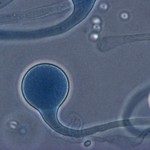Lien vers Pubmed [PMID] – 34668768
Lien DOI – 10.1128/Spectrum.01138-21
Microbiol Spectr 2021 Oct; 9(2): e0113821
The aim of this study was to evaluate diagnostic means, host factors, delay of occurrence, and outcome of patients with COVID-19 pneumonia and fungal coinfections in the intensive care unit (ICU). From 1 February to 31 May 2020, we anonymously recorded COVID-19-associated pulmonary aspergillosis (CAPA), fungemia (CA-fungemia), and pneumocystosis (CA-PCP) from 36 centers, including results on fungal biomarkers in respiratory specimens and serum. We collected data from 154 episodes of CAPA, 81 of CA-fungemia, 17 of CA-PCP, and 5 of other mold infections from 244 patients (male/female [M/F] ratio = 3.5; mean age, 64.7 ± 10.8 years). CA-PCP occurred first after ICU admission (median, 1 day; interquartile range [IQR], 0 to 3 days), followed by CAPA (9 days; IQR, 5 to 13 days), and then CA-fungemia (16 days; IQR, 12 to 23 days) (P < 10-4). For CAPA, the presence of several mycological criteria was associated with death (P < 10-4). Serum galactomannan was rarely positive (<20%). The mortality rates were 76.7% (23/30) in patients with host factors for invasive fungal disease, 45.2% (14/31) in those with a preexisting pulmonary condition, and 36.6% (34/93) in the remaining patients (P = 0.001). Antimold treatment did not alter prognosis (P = 0.370). Candida albicans was responsible for 59.3% of CA-fungemias, with a global mortality of 45.7%. For CA-PCP, 58.8% of the episodes occurred in patients with known host factors of PCP, and the mortality rate was 29.5%. CAPA may be in part hospital acquired and could benefit from antifungal prescription at the first positive biomarker result. CA-fungemia appeared linked to ICU stay without COVID-19 specificity, while CA-PCP may not really be a concern in the ICU. Improved diagnostic strategy for fungal markers in ICU patients with COVID-19 should support these hypotheses. IMPORTANCE To diagnose fungal coinfections in patients with COVID-19 in the intensive care unit, it is necessary to implement the correct treatment and to prevent them if possible. For COVID-19-associated pulmonary aspergillosis (CAPA), respiratory specimens remain the best approach since serum biomarkers are rarely positive. Timing of occurrence suggests that CAPA could be hospital acquired. The associated mortality varies from 36.6% to 76.7% when no host factors or host factors of invasive fungal diseases are present, respectively. Fungemias occurred after 2 weeks in ICUs and are associated with a mortality rate of 45.7%. Candida albicans is the first yeast species recovered, with no specificity linked to COVID-19. Pneumocystosis was mainly found in patients with known immunodepression. The diagnosis occurred at the entry in ICUs and not afterwards, suggesting that if Pneumocystis jirovecii plays a role, it is upstream of the hospitalization in the ICU.






